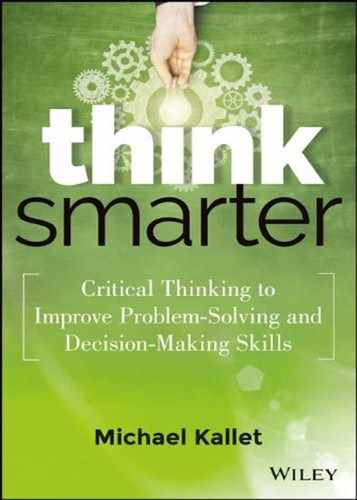12 Vision
What Is Your Vision?
The last tool I'll introduce for clarity might actually end up being the first you use. It's a description of your vision about your headscratcher solution. You simply answer the question “What does the world look like after you solve this problem?” Describe the end state; then ask whether, given your vision, is this headscratcher the only thing you have to solve? If the answer is no, then what other headscratchers might you need to solve to make the world look like the one you envisioned?
Having a vision conversation can be both enlightening and depressing. On the plus side, you articulate what you're trying to accomplish—the big picture, the main goal. However, you generally end up with a list of headscratchers to solve after having this conversation. Sometimes, you'll have started the process with one problem only to realize you have a whole bunch of problems—a list of issues you need to solve to reach your vision. It's deflating, but with that always-a-way attitude, you will pick one to start with. You should reexamine your list at this point and make sure the headscratcher you've chosen to tackle first will have the most impact on your vision. If not, switch to another.
For example, let's say your headscratcher is “How do we improve our productivity?” You use the common tools—inspection, why, and so what—and at one point, you ask what the world will look like when productivity improves. You surmise that you'll create more functional and higher quality products in half your competitors' time—thereby doubling your market share. That's a lofty vision. Is improving productivity the only headscratcher you need to solve to reach that goal? No. Others might be:
- How do you shorten your product development cycle by 50 percent?
- How do you ensure your products fulfill customers' needs?
- What tools and methods will keep your defect rate less than one part per million?
Given the vision and new list of headscratchers to work on, you are in the position to ask one more question: If your vision is as described, are you starting with the right headscratcher—or might you make a greater impact by starting with another?
Articulating your vision and relating it to headscratchers is a great tool for aligning teams. The vision defines a common need and definition. As a result, you develop a true understanding of whether people are doing the appropriate work—that which contributes to the achievement of the vision.
Getting Started with Vision
Here are a few places you can use vision:
- To get clear on the purpose: When someone asks why about an initiative, one potential response is to relate that initiative back to the vision. If the person understands the vision and the relationship to the initiative is clear, then you have answered the why.
- To set the stage for goals and problem solving: As a leader, you may have a vision of what you want to happen or what you want your team, department, division, or company to achieve. However, you may not have a list of specific problems to solve to achieve it. Once you communicate the vision, you can then engage others to help figure out what headscratchers you need to solve to accomplish that vision.
- As a gatekeeper for initiatives and problems to solve: When someone comes forward with a new idea, goal, or set of initiatives and subsequent problems to solve, you can use a vision conversation to determine whether you need to allocate any resources. The question to ask is “How does this new objective contribute to achieving the vision?”
- As an artificial need: Needs don't have to be real, but they must be perceived to be real. As you read in Chapter 8, it's crucial to identify need to ensure things get done. One way to generate a need is to paint a vision so exciting and desirable that it becomes an emotional need. This can provide a very strong connection for people involved. For example, “We want to achieve a reputation as the most valuable and highest quality call center in the world.” If your employees really want that emotional accomplishment, then it becomes an emotional need—which is as good as a material one.
The Takeaway
Using your vision to describe the end state helps bring out other initiatives, problems, issues, and decisions to consider. Sometimes you'll change your focus to work on something with more impact.
Exercises for Vision
- Write down your vision for your retirement. What headscratchers need to be solved to accomplish that vision?
- Does your team, your department, your division, or your company have a vision? If so, list your top three priorities, and explain how they contribute to that vision.
- What is your 10-year vision for your career? What headscratchers do you need to solve to accomplish that? Are you working on any of those now? If not, why not?
- What are some needs associated with some of the preceding visions, for example, your retirement? One need might be to take care of yourself and your spouse with food, shelter, and health. Another might be to be able to visit your children, and another could be a need to be intellectually involved in something. Try using the ingredient diagram tool to map out other needs.
